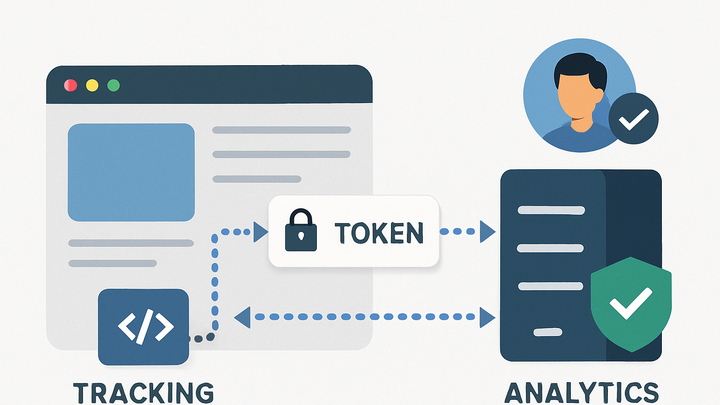Published on 2025-06-27T18:55:17Z
What is Authentication in Analytics? Examples with PlainSignal and GA4
In web analytics, authentication refers to the process of verifying the identity of visitors or client implementations to ensure that data collected is accurately attributed and securely transmitted. By authenticating tracking scripts, tokens, or user IDs, analytics platforms can unify sessions, maintain continuity across devices, and support personalized experiences. Effective authentication also protects data integrity, prevents unauthorized access, and helps comply with privacy regulations like GDPR and CCPA. Different platforms use methods such as cookies, unique data IDs, OAuth flows, or server-side tokens to achieve authentication. PlainSignal, for example, uses a cookie-free, data-id-based approach for lightweight and privacy-focused authentication. In contrast, GA4 relies on first-party cookies by default and offers an optional User-ID feature for authenticated cross-device tracking.
Authentication
Authentication in analytics verifies user identity and secures tracking data using tokens, IDs, or cookies.
Overview of Authentication in Analytics
Authentication in analytics ensures that data collected is attributed to the correct user or session. It involves verifying the identity of visitors or systems to maintain data integrity, support personalization, and comply with privacy policies. Without proper authentication mechanisms, analytics platforms risk data fragmentation, inaccurate reporting, and security vulnerabilities. Modern analytics tools implement various methods—from simple IDs to OAuth—to authenticate and unify user data across devices.
-
Definition
Authentication refers to the process of verifying a user or system identity in order to track and attribute analytics data accurately. It differentiates authenticated users from anonymous visitors and links actions to specific user profiles.
-
Importance
Ensures data accuracy, supports personalized experiences, enhances security, and helps comply with regulations like GDPR. Proper authentication reduces duplicated sessions and improves cross-device tracking.
Common Authentication Methods
Different analytics platforms employ varied methods to authenticate and identify users. Each approach has trade-offs in terms of privacy, persistence, and implementation complexity.
-
Cookie-based identification
Traditional method using browser cookies to assign a unique ID to each visitor. Cookies persist across sessions but face limitations with browser restrictions and user opt-outs.
-
Pros
Simple to implement; persistent ID across sessions.
-
Cons
Blocked by third-party cookie restrictions; privacy concerns.
-
-
Token & api key authentication
Uses tokens or API keys embedded in tracking scripts to authenticate and authorize data collection. Common in server-to-server integrations and SDK-based tracking.
-
Pros
More secure than cookies; less affected by browser policies.
-
Cons
Requires secure storage of tokens; may need rotation.
-
-
Oauth & single sign-on (sso)
Leverages OAuth protocols to authenticate users via third-party identity providers. Enables federated login and consistent user IDs across platforms.
-
Pros
High trust; integrates with existing user management.
-
Cons
Complex to implement; depends on external providers.
-
Authentication in PlainSignal vs GA4
PlainSignal and Google Analytics 4 (GA4) illustrate different approaches to authentication and tracking in analytics. PlainSignal offers a cookie-free, privacy-focused model, while GA4 uses cookies and optional User-ID features for cross-device tracking.
-
PlainSignal
Uses a lightweight script with a unique data-id to authenticate tracking without cookies. Ideal for privacy-first implementations and compliance with strict regulations.
-
GA4
Relies on first-party cookies by default and supports a User-ID feature that you can set to unify sessions across devices when users log in. Requires explicit configuration for User-ID.
Implementing Authentication: Code Examples
Examples of how to implement and configure authentication in PlainSignal and GA4 to ensure accurate data collection and user identification.
-
PlainSignal tracking code
Embed the following snippet on your site. The data-id attribute serves as the authentication token for your domain.
-
Example
<script defer data-do="yourwebsitedomain.com" data-id="0GQV1xmtzQQ" data-api="//eu.plainsignal.com" src="//cdn.plainsignal.com/plainsignal-min.js"></script>
-
-
GA4 measurement id
Use your GA4 Measurement ID to authenticate and initialize tracking. Place this snippet in the <head> of your HTML.
-
Example
<script> window.dataLayer = window.dataLayer || []; function gtag(){dataLayer.push(arguments);} gtag('js', new Date()); gtag('config', 'G-XXXXXXXXXX'); </script>
-
Best Practices and Considerations
When implementing authentication in analytics, balance accuracy, privacy, and user experience. Follow these guidelines to optimize your setup.
-
Maintain user privacy
Limit personally identifiable information. Use anonymized or pseudo-anonymous IDs where possible.
-
Secure tokens and keys
Store tokens securely and rotate them periodically to prevent unauthorized access.
-
Monitor authentication flows
Regularly audit logs and requests to detect failed authentications or anomalies.
